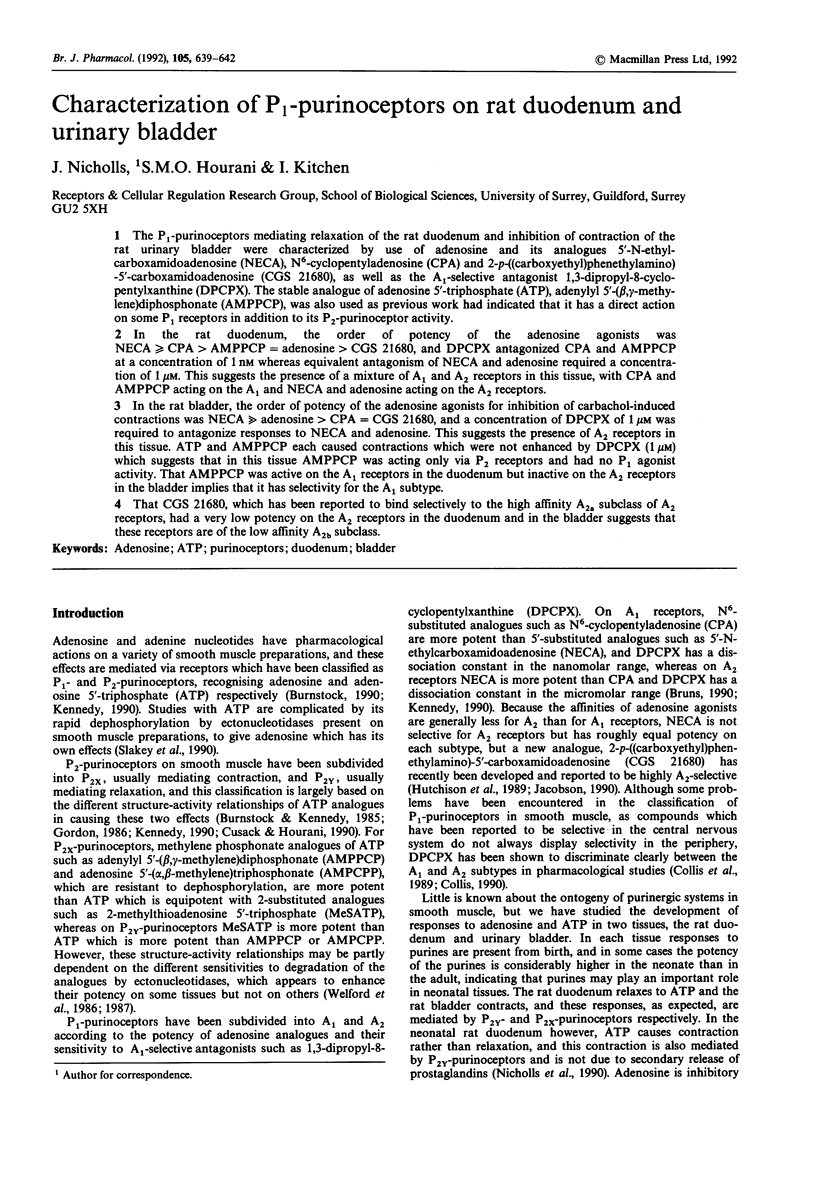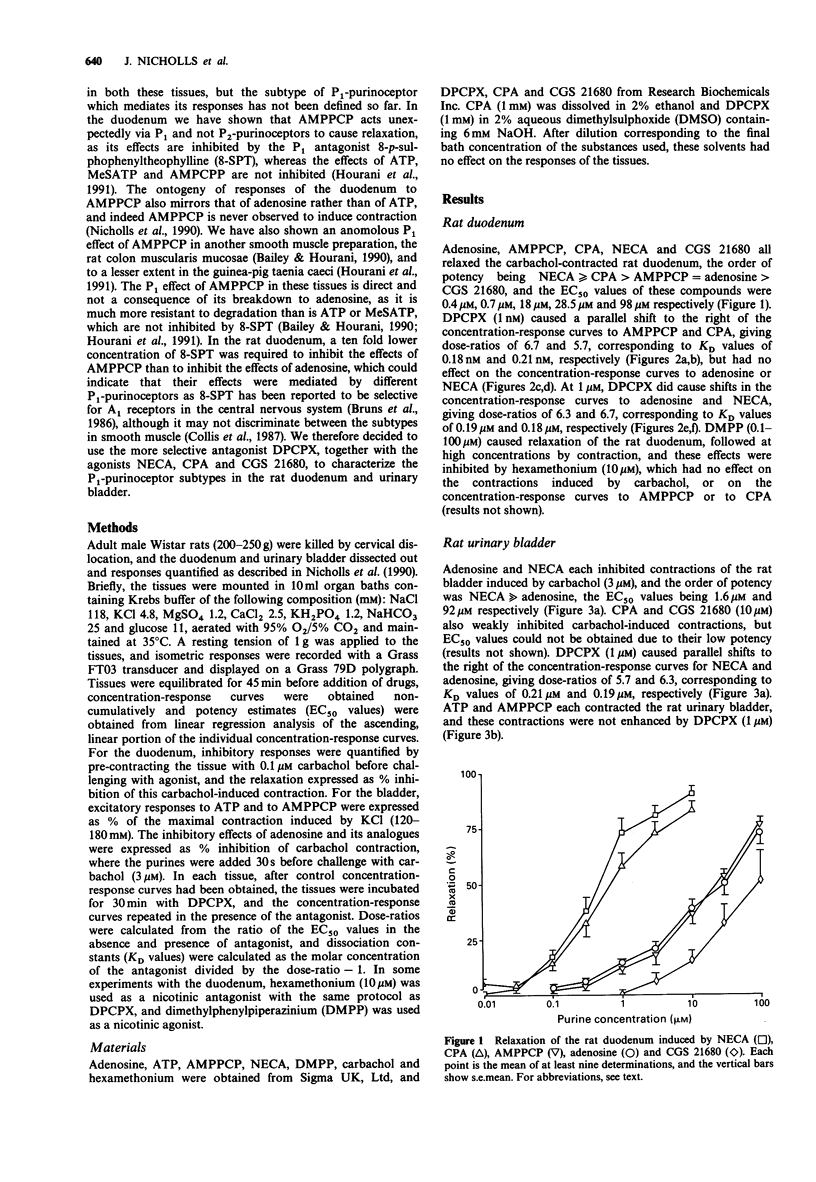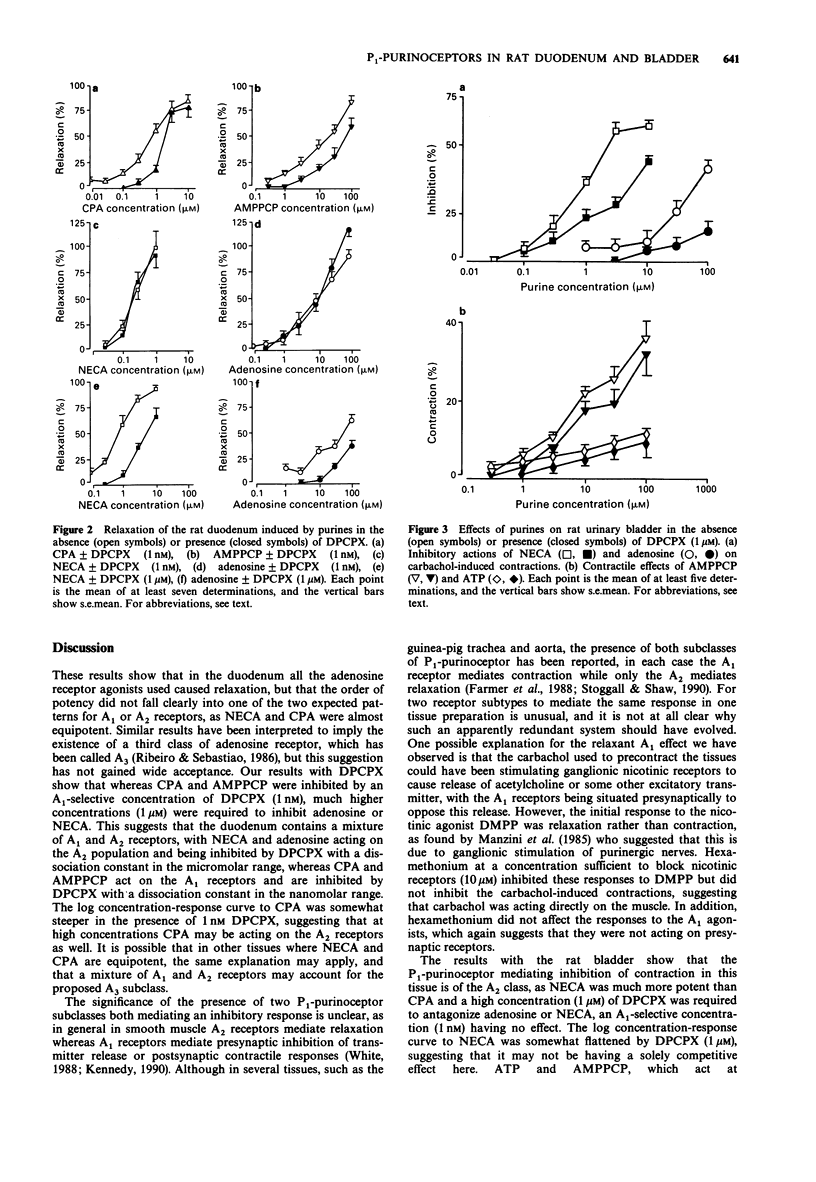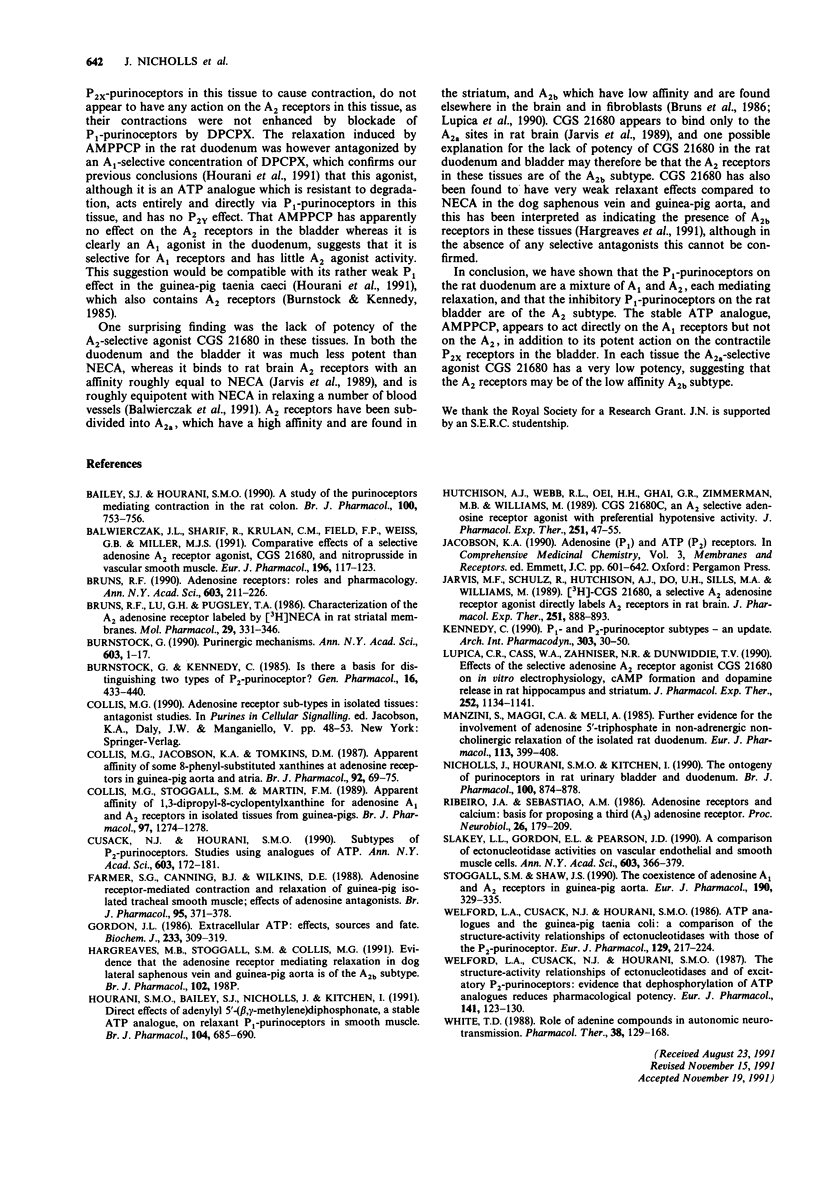Abstract
1. The P1-purinoceptors mediating relaxation of the rat duodenum and inhibition of contraction of the rat urinary bladder were characterized by use of adenosine and its analogues 5'-N-ethylcarboxamidoadenosine (NECA), N6-cyclopentyladenosine (CPA) and 2-p-((carboxyethyl)phenethylamino)-5'- carboxamidoadenosine (CGS 21680), as well as the A1-selective antagonist 1,3-dipropyl-8-cyclopentylxanthine (DPCPX). The stable analogue of adenosine 5'-triphosphate (ATP), adenylyl 5'-(beta,gamma-methylene)diphosphonate (AMPPCP), was also used as previous work had indicated that it has a direct action on some P1 receptors in addition to its P2-purinoceptor activity. 2. In the rat duodenum, the order of potency of the adenosine agonists was NECA greater than or equal to CPA greater than AMPPCP = adenosine greater than CGS 21680, and DPCPX antagonized CPA and AMPPCP at a concentration of 1 nM whereas equivalent antagonism of NECA and adenosine required a concentration of 1 microM. This suggests the presence of a mixture of A1 and A2 receptors in this tissue, with CPA and AMPPCP acting on the A1 and NECA and adenosine acting on the A2 receptors. 3. In the rat bladder, the order of potency of the adenosine agonists for inhibition of carbachol-induced contractions was NECA much greater than adenosine greater than CPA = CGS 21680, and a concentration of DPCPX of 1 microM was required to antagonize responses to NECA and adenosine. This suggests the presence of A2 receptors in this tissue.(ABSTRACT TRUNCATED AT 250 WORDS)
Full text
PDF



Selected References
These references are in PubMed. This may not be the complete list of references from this article.
- Bailey S. J., Hourani S. M. A study of the purinoceptors mediating contraction in the rat colon. Br J Pharmacol. 1990 Aug;100(4):753–756. doi: 10.1111/j.1476-5381.1990.tb14087.x. [DOI] [PMC free article] [PubMed] [Google Scholar]
- Balwierczak J. L., Sharif R., Krulan C. M., Field F. P., Weiss G. B., Miller M. J. Comparative effects of a selective adenosine A2 receptor agonist, CGS 21680, and nitroprusside in vascular smooth muscle. Eur J Pharmacol. 1991 Apr 17;196(2):117–123. doi: 10.1016/0014-2999(91)90416-n. [DOI] [PubMed] [Google Scholar]
- Bruns R. F. Adenosine receptors. Roles and pharmacology. Ann N Y Acad Sci. 1990;603:211–226. doi: 10.1111/j.1749-6632.1990.tb37674.x. [DOI] [PubMed] [Google Scholar]
- Bruns R. F., Lu G. H., Pugsley T. A. Characterization of the A2 adenosine receptor labeled by [3H]NECA in rat striatal membranes. Mol Pharmacol. 1986 Apr;29(4):331–346. [PubMed] [Google Scholar]
- Burnstock G., Kennedy C. Is there a basis for distinguishing two types of P2-purinoceptor? Gen Pharmacol. 1985;16(5):433–440. doi: 10.1016/0306-3623(85)90001-1. [DOI] [PubMed] [Google Scholar]
- Burnstock G. Overview. Purinergic mechanisms. Ann N Y Acad Sci. 1990;603:1–18. doi: 10.1111/j.1749-6632.1990.tb37657.x. [DOI] [PubMed] [Google Scholar]
- Collis M. G., Jacobson K. A., Tomkins D. M. Apparent affinity of some 8-phenyl-substituted xanthines at adenosine receptors in guinea-pig aorta and atria. Br J Pharmacol. 1987 Sep;92(1):69–75. doi: 10.1111/j.1476-5381.1987.tb11297.x. [DOI] [PMC free article] [PubMed] [Google Scholar]
- Collis M. G., Stoggall S. M., Martin F. M. Apparent affinity of 1,3-dipropyl-8-cyclopentylxanthine for adenosine A1 and A2 receptors in isolated tissues from guinea-pigs. Br J Pharmacol. 1989 Aug;97(4):1274–1278. doi: 10.1111/j.1476-5381.1989.tb12589.x. [DOI] [PMC free article] [PubMed] [Google Scholar]
- Cusack N. J., Hourani S. M. Subtypes of P2-purinoceptors. Studies using analogues of ATP. Ann N Y Acad Sci. 1990;603:172–181. doi: 10.1111/j.1749-6632.1990.tb37671.x. [DOI] [PubMed] [Google Scholar]
- Farmer S. G., Canning B. J., Wilkins D. E. Adenosine receptor-mediated contraction and relaxation of guinea-pig isolated tracheal smooth muscle: effects of adenosine antagonists. Br J Pharmacol. 1988 Oct;95(2):371–378. doi: 10.1111/j.1476-5381.1988.tb11655.x. [DOI] [PMC free article] [PubMed] [Google Scholar]
- Gordon J. L. Extracellular ATP: effects, sources and fate. Biochem J. 1986 Jan 15;233(2):309–319. doi: 10.1042/bj2330309. [DOI] [PMC free article] [PubMed] [Google Scholar]
- Hourani S. M., Bailey S. J., Nicholls J., Kitchen I. Direct effects of adenylyl 5'-(beta,gamma-methylene)diphosphonate, a stable ATP analogue, on relaxant P1-purinoceptors in smooth muscle. Br J Pharmacol. 1991 Nov;104(3):685–690. doi: 10.1111/j.1476-5381.1991.tb12489.x. [DOI] [PMC free article] [PubMed] [Google Scholar]
- Hutchison A. J., Webb R. L., Oei H. H., Ghai G. R., Zimmerman M. B., Williams M. CGS 21680C, an A2 selective adenosine receptor agonist with preferential hypotensive activity. J Pharmacol Exp Ther. 1989 Oct;251(1):47–55. [PubMed] [Google Scholar]
- Jarvis M. F., Schulz R., Hutchison A. J., Do U. H., Sills M. A., Williams M. [3H]CGS 21680, a selective A2 adenosine receptor agonist directly labels A2 receptors in rat brain. J Pharmacol Exp Ther. 1989 Dec;251(3):888–893. [PubMed] [Google Scholar]
- Kennedy C. P1- and P2-purinoceptor subtypes--an update. Arch Int Pharmacodyn Ther. 1990 Jan-Feb;303:30–50. [PubMed] [Google Scholar]
- Lupica C. R., Cass W. A., Zahniser N. R., Dunwiddie T. V. Effects of the selective adenosine A2 receptor agonist CGS 21680 on in vitro electrophysiology, cAMP formation and dopamine release in rat hippocampus and striatum. J Pharmacol Exp Ther. 1990 Mar;252(3):1134–1141. [PubMed] [Google Scholar]
- Manzini S., Maggi C. A., Meli A. Further evidence for involvement of adenosine-5'-triphosphate in non-adrenergic non-cholinergic relaxation of the isolated rat duodenum. Eur J Pharmacol. 1985 Jul 31;113(3):399–408. doi: 10.1016/0014-2999(85)90088-3. [DOI] [PubMed] [Google Scholar]
- Moore P. K., Oluyomi A. O., Babbedge R. C., Wallace P., Hart S. L. L-NG-nitro arginine methyl ester exhibits antinociceptive activity in the mouse. Br J Pharmacol. 1991 Jan;102(1):198–202. doi: 10.1111/j.1476-5381.1991.tb12153.x. [DOI] [PMC free article] [PubMed] [Google Scholar]
- Nicholls J., Hourani S. M., Kitchen I. The ontogeny of purinoceptors in rat urinary bladder and duodenum. Br J Pharmacol. 1990 Aug;100(4):874–878. doi: 10.1111/j.1476-5381.1990.tb14107.x. [DOI] [PMC free article] [PubMed] [Google Scholar]
- Ribeiro J. A., Sebastião A. M. Adenosine receptors and calcium: basis for proposing a third (A3) adenosine receptor. Prog Neurobiol. 1986;26(3):179–209. doi: 10.1016/0301-0082(86)90015-8. [DOI] [PubMed] [Google Scholar]
- Slakey L. L., Gordon E. L., Pearson J. D. A comparison of ectonucleotidase activities on vascular endothelial and smooth muscle cells. Ann N Y Acad Sci. 1990;603:366–379. doi: 10.1111/j.1749-6632.1990.tb37686.x. [DOI] [PubMed] [Google Scholar]
- Stoggall S. M., Shaw J. S. The coexistence of adenosine A1 and A2 receptors in guinea-pig aorta. Eur J Pharmacol. 1990 Nov 13;190(3):329–335. doi: 10.1016/0014-2999(90)94197-6. [DOI] [PubMed] [Google Scholar]
- Welford L. A., Cusack N. J., Hourani S. M. ATP analogues and the guinea-pig taenia coli: a comparison of the structure-activity relationships of ectonucleotidases with those of the P2-purinoceptor. Eur J Pharmacol. 1986 Oct 7;129(3):217–224. doi: 10.1016/0014-2999(86)90431-0. [DOI] [PubMed] [Google Scholar]
- Welford L. A., Cusack N. J., Hourani S. M. The structure-activity relationships of ectonucleotidases and of excitatory P2-purinoceptors: evidence that dephosphorylation of ATP analogues reduces pharmacological potency. Eur J Pharmacol. 1987 Sep 2;141(1):123–130. doi: 10.1016/0014-2999(87)90418-3. [DOI] [PubMed] [Google Scholar]
- White T. D. Role of adenine compounds in autonomic neurotransmission. Pharmacol Ther. 1988;38(2):129–168. doi: 10.1016/0163-7258(88)90095-2. [DOI] [PubMed] [Google Scholar]


